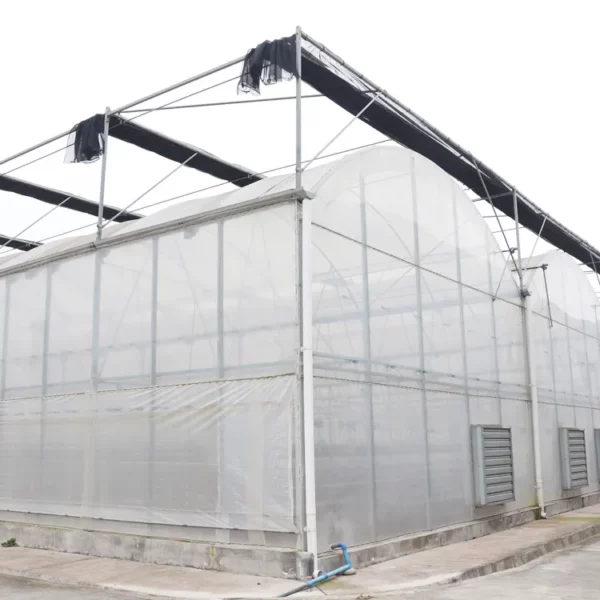Outdoor greenhouses, also known as hoop houses or low tunnels, were designed to provide a controlled environment for plant growth and protection from external weather conditions.
Here are some reasons why outdoor greenhouses were developed:
- Season Extension: Outdoor greenhouses allow for the extension of the growing season by creating a microclimate that is more favorable than the surrounding outdoor conditions. By covering plants with a greenhouse structure, growers can protect them from frost, cold temperatures, and other adverse weather conditions, thus enabling cultivation during colder months or in regions with shorter growing seasons.
- Crop Protection: Greenhouses provide a physical barrier against pests, insects, and certain diseases. By covering plants, growers can prevent pests from directly accessing the crops, reduce damage caused by pests, and limit the need for chemical pesticides. This protection is particularly beneficial for organic farming and sustainable agricultural practices.
- Temperature Regulation: Outdoor greenhouses help regulate temperature fluctuations, maintaining a more stable and controlled environment for plants. During cooler periods, the greenhouse traps solar radiation, creating a warmer space for the plants. Conversely, during hot weather, proper ventilation techniques can be employed to prevent excessive heat buildup, ensuring optimal growing conditions.
- Enhanced Plant Growth: The controlled environment within outdoor greenhouses promotes better plant growth and development. By optimizing temperature, humidity, and light levels, growers can create conditions that encourage faster germination, improved root development, and overall healthier plants. This can result in higher yields, better quality produce, and more efficient resource utilization.
- Cost-Effectiveness: Outdoor greenhouses are generally more cost-effective compared to larger, more complex greenhouse structures. They require less initial investment and can be easily constructed using materials such as PVC pipes and plastic film coverings. This affordability makes them accessible to small-scale farmers, backyard gardeners, and those with limited resources.
- Versatility and Portability: Outdoor greenhouses offer flexibility in terms of design and size. They can be constructed in various shapes and sizes to accommodate different crop types and cultivation methods. Additionally, they can be easily disassembled and relocated to different areas of the farm or garden if needed.
- Research and Experimentation: Outdoor greenhouses are often used for research and experimentation purposes. They provide controlled testing environments for studying plant physiology, evaluating new varieties, testing cultivation techniques, and conducting experiments to improve crop productivity and sustainability.
Overall, outdoor green houses were designed to provide a practical and affordable solution for extending the growing season, protecting crops, and creating favorable conditions for plant growth in various climates and environments.
What are some common materials used to construct outdoor greenhouses?
Outdoor greenhouses, also known as hoop houses or low tunnels, can be constructed using a variety of materials.
Here are some common materials used for building outdoor greenhouses:
- PVC Pipes: PVC (polyvinyl chloride) pipes are a popular choice for constructing the framework of outdoor greenhouses. They are lightweight, affordable, and easy to work with. PVC pipes can be bent or shaped to form hoops that create the structure of the greenhouse. They are typically available in various diameters, allowing for flexibility in greenhouse design.
- Metal Pipes: Galvanized steel or aluminum pipes are also commonly used to construct the framework of outdoor greenhouses. They are more durable and sturdier than PVC pipes, providing increased structural integrity. Metal pipes are often used for larger or more permanent greenhouse structures.
- Wood: Wood is another option for constructing the framework of outdoor greenhouses, especially for larger or more permanent structures. Treated lumber or rot-resistant woods like cedar are commonly used due to their resistance to moisture and decay. Wood can be used for building the base, framing the structure, and creating supporting elements.
- Plastic Film Coverings: Plastic film is the most common material used to cover the framework of outdoor greenhouses. Typically, polyethylene (PE) greenhouse film or polyvinyl chloride (PVC) film is used. These films are lightweight, cost-effective, and provide excellent light transmission while retaining heat. They can be attached to the framework using clips, staples, or specialized greenhouse fasteners.
- Polycarbonate Panels: Polycarbonate panels are a more durable alternative to plastic film coverings. They offer better insulation, UV protection, and impact resistance. Polycarbonate panels are often used for larger or more permanent outdoor greenhouse structures where higher durability and longevity are desired.
- Shade Cloth: Shade cloth is a woven fabric that can be used to provide shade and regulate light levels within an outdoor greenhouse. It helps protect plants from excessive sunlight and heat during hot summer months. Shade cloth is available in different densities, allowing growers to control the amount of shade provided.
- Fasteners and Connectors: Various fasteners and connectors are used to join the framework elements of outdoor greenhouses. These can include plastic or metal clips, brackets, bolts, screws, or specialized connectors designed for greenhouse construction. These components ensure the stability and integrity of the greenhouse structure.
It’s important to note that the choice of materials may vary depending on factors such as budget, climate conditions, intended use, and the desired lifespan of the outdoor greenhouse. Additionally, local building codes and regulations should be considered when selecting materials and constructing outdoor greenhouses.
